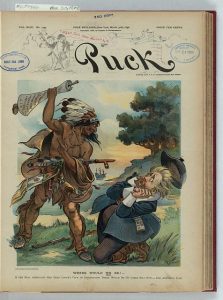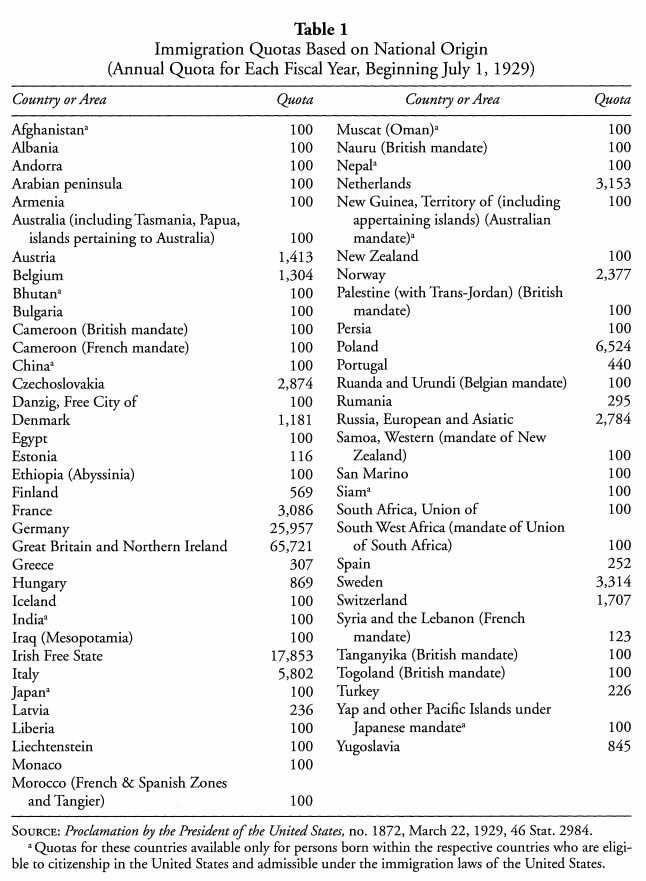Summary
The 1921 Emergency Quota Act had been so effective in reducing immigration that Congress hastened to enact the quota system permanently. This Act set its quotas to 2 percent of resident populations counted in the 1890 census, capping overall immigration at 150,000 per year. With a few exemptions, such as specialized employment, education, or tourism, it barred altogether “aliens ineligible for citizenship.” Eastern and southern Europeans were most severely affected by reductions in legal immigration. The “national origins” quota system to limit immigration selectively was quantitatively discriminatory and would remain the primary principle determining admissibility to the United States until 1965. In consideration of maintaining good relations with its closest neighbors in the region, immigration within the Western hemisphere remained uncapped.
The “national origins” quotas were enforced by a system of “remote control.” Prospective immigrants were required to apply for visas at the U.S. consulate or embassy closest to their homes where they were interviewed and their applications evaluated, accepted or turned down far away from U.S. shores. Immigration numbers fell immediately and dramatically, and particularly from targeted areas of eastern and southern Europe. This system enabled consular authorities during the 1930s to deny visas to Jews attempting to flee the spread of Nazism in Europe, including the family of Anne Frank.
Criticism and calls for reform from many quarters ensued as soon as the openly discriminatory quotas were legislated.

Print shows Henry Cabot Lodge cowering before a Native who is about to hit him with a club around which a paper is wrapped that states “An Act to Prevent the Country from being Overrun by Foreigners”.
Library of Congress.
Source
Chap. 190.-An Act to limit the immigration of aliens into the United States and for other purposes.
Application for Immigration Visa.
Sec. 7. (a) Every immigrant applying for an immigration visa shall make application therefor in duplicate in such form as shall be by regulations prescribed. . . The immigrant shall furnish, if available, to the consular officer, with his application, two copies of his ”dossier” and prison record and military record, two certified copies of his birth certificate, and two copies of all other available public records concerning him kept by the Government to which he owes allegiance. . . In the application the immigrant shall also state . . . whether or not he is a member of each class of individuals excluded from admission to the United States under the immigration laws . . . .
Issuance of Immigration Visas to Relatives
Sec. 9 . . . . Any citizen of the United States claiming that any immigrant is his relative, and that such immigrant is properly admissible to the United States as a non-quota immigrant . . . may file with the Commissioner General a petition . . . If the Commissioner General finds the facts stated in the petition to be true, and that the immigrant in respect of whom the petition is made is entitled to be admitted to the United States as a non-quota immigrant . . . he shall, with the approval of the Secretary of Labor, inform the Secretary of State of his decision, and the Secretary of State shall then authorize the consular officer with whom the application for the immigration visa has been filed to issue the immigration visa or grant the preference. . . .
Numerical Limitations.
Sec. 11. (a) The annual quota of any nationality shall be 2 per centum of the number of foreign born individuals of such nationality resident in continental United States as determined by the United States census of 1890, but the minimum quota of any nationality shall be 100. (b) The annual quota of any nationality for the fiscal year beginning July 1, 1927, and for each fiscal year thereafter, shall be a number which bears the same ratio to 150,000 as the number of inhabitants in continental United States in 1920 having that national origin (ascertained as hereinafter provided in this section) bears to the number of inhabitants in continental United States in 1920, but the minimum quota of any nationality shall be 100.
Deportation.
Sec. 14. Any alien who at any time after entering the United States is found to have been at the time of entry not entitled under this Act to enter the United States, or to have remained therein for a longer time than permitted under this Act . . . shall be taken into custody and deported in the same manner as provided for in sections 19 and 20 of the Immigration Act of 1917: Provided, That the Secretary of Labor may . . . permit permanently to remain in the United States, any alien child who, when under sixteen years of age was heretofore temporarily admitted to the United States and who is now within the United States and either of whose parents is a citizen of the United States.
Burden of Proof.
Sec. 23. Whenever any alien attempts to enter the United States the burden of proof shall be upon such alien to establish that he is not subject to exclusion under any provision of the immigration laws; and in any deportation proceeding against any alien the burden of proof shall be upon such alien to show that he entered the United States lawfully . . . .
Approved, May 26, 1924.

Analysis
“Prominent eugenicist Harry Laughlin… wrote, ‘Henceforth, after 1924, the immigrant to the United States was to be looked upon, not as a source of cheap or competitive labor, nor as one seeking asylum from foreign oppression, nor as a migrant hunting a less strenuous life, but as a parent of future-born American citizens. This mean that the hereditary stuff out of which future immigrants were made would have to be compatible racially with American ideals.’
The stakes of immigration restriction, as defined by the eugenically minded, ultimately determined the shape of the new legislation. The formula that was finally written into the Johnson Act-that is, a quota system based on 2 percent of each group’s population according to the 1890 census-originally emerged in a Report of the Eugenics Committee of the United States Committee on Selective Immigration. That committee, chaired by none other than Madison Grant and including Congressman Albert Johnson of Washington (the president of the Eugenic Research Association, 1923-1924), argued that a formula based on the 1890 census rather than on a more recent one “would change the character of immigration, and hence of our future population, by bringing about a preponderance of immigration of the stock which originally settled this country.” North and West Europeans, read the report, were of “higher intelligence” and hence provided “the best material for American citizenship” (pp. 82-83)
Excerpt from:
Jacobson, M. F. (1998). Whiteness of a different color: European immigrants and the alchemy of race. Cambridge, MA: Harvard University Press.

